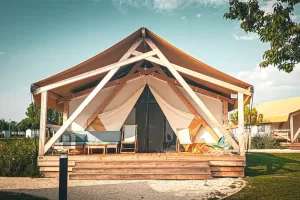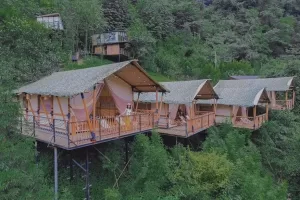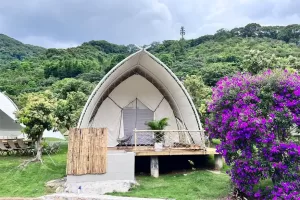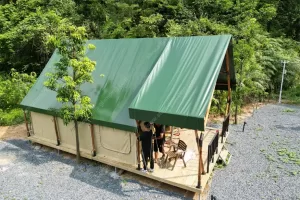Eco-friendly glamping has gained immense popularity as travelers seek to blend luxury with sustainability. These accommodations not only offer comfort but also prioritize environmental responsibility, allowing guests to enjoy nature while minimizing their impact on the environment. Here’s an overview of the most popular eco-friendly glamping accommodations and the sustainable practices that make them stand out.

Types of Eco-Friendly Glamping Accommodations
Yurts
Yurts, traditionally used by nomadic cultures, are now a staple of eco-glamping. Their circular design and lightweight structure make them ideal for environmentally conscious travelers.
- Sustainability Features: Made with natural or sustainable materials, many modern yurts are equipped with solar-powered lighting and heating, reducing reliance on fossil fuels. Their efficient insulation makes them energy-efficient year-round, while some yurts include composting toilets to further minimize waste.
Treehouses
Treehouses provide a magical, immersive experience with nature, elevated among the trees. They’re often built to coexist with the surrounding environment.
- Sustainability Features: Constructed using reclaimed wood or sustainable materials, many treehouses use solar panels to power basic amenities. They typically preserve the forest floor, minimizing ecological disruption, and often integrate rainwater harvesting systems for showers and irrigation.
Luxury Tents
Luxury tents offer a refined camping experience, with all the comforts of home. These tents prioritize sustainability without sacrificing the guest experience.
- Sustainability Features: Luxury tents are commonly made from biodegradable materials like cotton canvas. Solar-powered lighting, energy-efficient heating, and locally sourced furnishings are frequent features, ensuring that guests can indulge in luxury while respecting the environment.
Eco Pods and Tiny Homes
Compact, minimalist, and energy-efficient, eco pods and tiny homes are perfect for travelers seeking a sustainable lifestyle even on vacation.
- Sustainability Features: These accommodations are often built using recycled or sustainable materials and are powered by renewable energy sources like solar or wind. They feature water-saving technologies, composting toilets, and greywater systems, making them a low-impact, eco-friendly option.
خيام سفاري
Safari tents bring the charm of traditional camping with added luxury and a strong emphasis on sustainability. These tents often resemble small homes with luxurious interiors.
- Sustainability Features: Built with eco-friendly materials such as bamboo, organic cotton, and recycled wood, safari tents often feature solar panels for electricity and sustainable insulation. Raised platforms prevent land disruption, preserving the natural landscape beneath.
Key Sustainable Practices in Eco-Friendly Glamping
Renewable Energy Sources
Many eco-friendly glamping sites reduce their carbon footprint by utilizing renewable energy sources. Solar panels and wind turbines provide clean, sustainable power for lighting, heating, and other amenities. This reduces reliance on non-renewable resources and significantly lowers the environmental impact of the site.
Water Conservation Technologies
Water conservation is a priority in eco-glamping. Many accommodations use rainwater harvesting systems and greywater recycling to minimize water consumption. Low-flow toilets and showerheads, as well as composting toilets, further help reduce water usage, making the stay more eco-friendly without sacrificing guest comfort.
Waste Management Systems
Effective waste management is a cornerstone of eco-friendly glamping. Glamping sites often implement recycling programs and composting systems to reduce landfill waste. Composting toilets and organic waste composting allow waste to be processed in a sustainable way, turning it into usable compost rather than harmful pollutants.
Sourcing Locally
Eco-glamping businesses often source materials, food, and supplies locally to reduce the carbon emissions associated with transportation. In some cases, sites grow their own food or offer farm-to-table dining experiences, enhancing sustainability while supporting the local economy. By sourcing locally, these glamping sites reduce their carbon footprint and promote regional growth.
Eco-Friendly Amenities
Guests will often find eco-friendly amenities such as biodegradable toiletries, organic bedding, and natural cleaning products. These small touches ensure that the glamping experience is luxurious while being environmentally responsible. Many sites avoid harsh chemicals in cleaning and maintenance, ensuring the environment remains unpolluted.
خاتمة
Eco-friendly glamping provides an excellent way to enjoy the outdoors while maintaining a commitment to sustainability. From yurts and treehouses to luxury tents and eco pods, there’s an eco-conscious accommodation for every type of traveler. By embracing renewable energy, water conservation, and waste management, eco-glamping strikes the perfect balance between luxury and responsibility. As the demand for sustainable travel options continues to grow, eco-friendly glamping is leading the way in offering memorable, luxurious experiences that also protect the environment for future generations.




